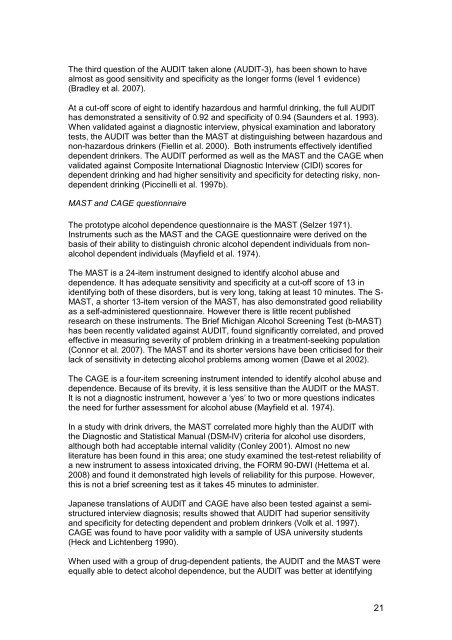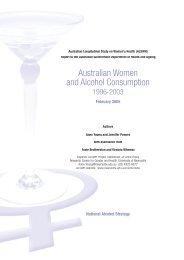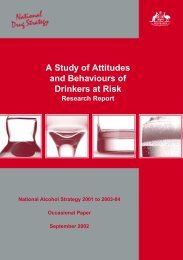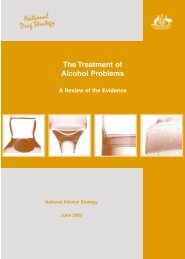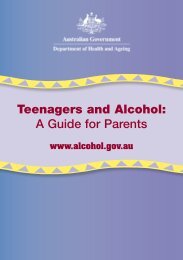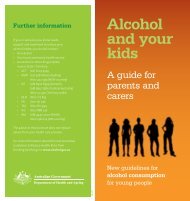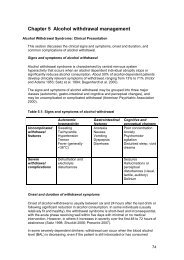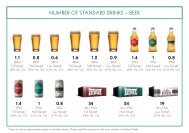Chapter 3 Screening, assessment and treatment planning - Alcohol
Chapter 3 Screening, assessment and treatment planning - Alcohol
Chapter 3 Screening, assessment and treatment planning - Alcohol
Create successful ePaper yourself
Turn your PDF publications into a flip-book with our unique Google optimized e-Paper software.
The third question of the AUDIT taken alone (AUDIT-3), has been shown to havealmost as good sensitivity <strong>and</strong> specificity as the longer forms (level 1 evidence)(Bradley et al. 2007).At a cut-off score of eight to identify hazardous <strong>and</strong> harmful drinking, the full AUDIThas demonstrated a sensitivity of 0.92 <strong>and</strong> specificity of 0.94 (Saunders et al. 1993).When validated against a diagnostic interview, physical examination <strong>and</strong> laboratorytests, the AUDIT was better than the MAST at distinguishing between hazardous <strong>and</strong>non-hazardous drinkers (Fiellin et al. 2000). Both instruments effectively identifieddependent drinkers. The AUDIT performed as well as the MAST <strong>and</strong> the CAGE whenvalidated against Composite International Diagnostic Interview (CIDI) scores fordependent drinking <strong>and</strong> had higher sensitivity <strong>and</strong> specificity for detecting risky, nondependentdrinking (Piccinelli et al. 1997b).MAST <strong>and</strong> CAGE questionnaireThe prototype alcohol dependence questionnaire is the MAST (Selzer 1971).Instruments such as the MAST <strong>and</strong> the CAGE questionnaire were derived on thebasis of their ability to distinguish chronic alcohol dependent individuals from nonalcoholdependent individuals (Mayfield et al. 1974).The MAST is a 24-item instrument designed to identify alcohol abuse <strong>and</strong>dependence. It has adequate sensitivity <strong>and</strong> specificity at a cut-off score of 13 inidentifying both of these disorders, but is very long, taking at least 10 minutes. The S-MAST, a shorter 13-item version of the MAST, has also demonstrated good reliabilityas a self-administered questionnaire. However there is little recent publishedresearch on these instruments. The Brief Michigan <strong>Alcohol</strong> <strong>Screening</strong> Test (b-MAST)has been recently validated against AUDIT, found significantly correlated, <strong>and</strong> provedeffective in measuring severity of problem drinking in a <strong>treatment</strong>-seeking population(Connor et al. 2007). The MAST <strong>and</strong> its shorter versions have been criticised for theirlack of sensitivity in detecting alcohol problems among women (Dawe et al 2002).The CAGE is a four-item screening instrument intended to identify alcohol abuse <strong>and</strong>dependence. Because of its brevity, it is less sensitive than the AUDIT or the MAST.It is not a diagnostic instrument, however a ‘yes’ to two or more questions indicatesthe need for further <strong>assessment</strong> for alcohol abuse (Mayfield et al. 1974).In a study with drink drivers, the MAST correlated more highly than the AUDIT withthe Diagnostic <strong>and</strong> Statistical Manual (DSM-IV) criteria for alcohol use disorders,although both had acceptable internal validity (Conley 2001). Almost no newliterature has been found in this area; one study examined the test-retest reliability ofa new instrument to assess intoxicated driving, the FORM 90-DWI (Hettema et al.2008) <strong>and</strong> found it demonstrated high levels of reliability for this purpose. However,this is not a brief screening test as it takes 45 minutes to administer.Japanese translations of AUDIT <strong>and</strong> CAGE have also been tested against a semistructuredinterview diagnosis; results showed that AUDIT had superior sensitivity<strong>and</strong> specificity for detecting dependent <strong>and</strong> problem drinkers (Volk et al. 1997).CAGE was found to have poor validity with a sample of USA university students(Heck <strong>and</strong> Lichtenberg 1990).When used with a group of drug-dependent patients, the AUDIT <strong>and</strong> the MAST wereequally able to detect alcohol dependence, but the AUDIT was better at identifying21


